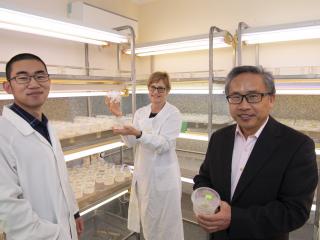Western Australia
July 30, 2020

Murdoch University post-doctoral research fellow Dr Yong Han, DPIRD research scientist Sue Broughton and WCGA director Professor Chengdao Li take plant material from the DPIRD Doubled Haploid Laboratory for gene-editing.
A recent breakthrough in gene editing technology will pave the way for more tailored barley varieties, with improved yield, quality and nitrogen-use efficiency.
The Western Crop Genetics Alliance, a partnership between the Department of Primary Industries and Regional Development (DPIRD) and Murdoch University, is behind the innovation.
The new technique enables barley genes to be accurately ‘turned on and off’ to create a superior trait – something that could not be achieved in Australian varieties with existing technology.
Alliance director Chengdao Li said the new technique, called Doubled Haploid CRISPR, provided scientists with a tool to precisely modify existing barley lines and craft enhanced varieties better suited to localised conditions.
Professor Li said the new technique was a technological leap for breeding new varieties that overcame the shortcomings of existing gene editing platforms for barley.
“Initial gene editing in barley relied on using immature embryos as a target for the editing process but this method was only workable in an old Scottish variety, as Australian varieties responded poorly to the technique,” he said.
“Australian varieties simply do not have the genetic characteristics required for the current CRISPR technology, which has created a major bottleneck for barley breeding in Australia.”
To overcome this constraint, Alliance scientists worked with DPIRD’s Cereal Doubled Haploid Program.
Professor Li said the Doubled Haploid CRISPR technology used the doubled haploid technique, which is used to generate fixed barley lines for plant breeders and researchers and has resulted in several commercial varieties.
“In this new approach, we use calli (plant cells) derived from immature pollen cells as a target for gene editing instead of immature embryos,” Professor Li said.
“We tested this approach on four major Australian barley varieties and achieved a successful editing rate of more than 50 per cent, which is comparable to the Scottish control variety, in the same amount of time of 10 months.”
Professor Li said the new technique would create new plant breeding opportunities for barley, as well as other crops.
“Most importantly, no off-target mutations were created, giving plant breeders, regulators and the community confidence in the stability and safety of this gene editing technique,” he said.
“A similar technique has been used in the United States in maize breeding, while the technique shows potential for use with other crops, including wheat, pulses and rice, as well as horticulture plants.”
Recent amendments to the Gene Technology Regulations exclude plants produced by this type of gene editing from being considered a genetically modified organism.
The technological finding was recently published in the esteemed international journal Plant Communications.
Murdoch University Pro Vice Chancellor for Food Futures Institute, Peter Davies, said the technological advancement built on the prior considerable achievements of the Alliance.
“The Alliance was a significant contributor to an international consortium that mapped the barley genome sequence, which has been integral to this work,” Professor Davies said.
“This technology is all very new, some of which has only emerged in the past five years and continues to advance quickly, so there will no doubt be further developments that will benefit growers, industry and global food security.”
DPIRD Primary Industries Development Managing Director Mark Sweetingham applauded the Alliance’s achievement, which he said would pave the way for the on-going profitability and sustainability of Western Australia’s grains industry.
“Technical innovation is key to improved productivity and plant breeding is a powerful tool to boost yields, disease resistance, water use efficiency and grain quality,’ Dr Sweetingham said.
“This translates to benefits to farm business, regional communities and the State economy.”